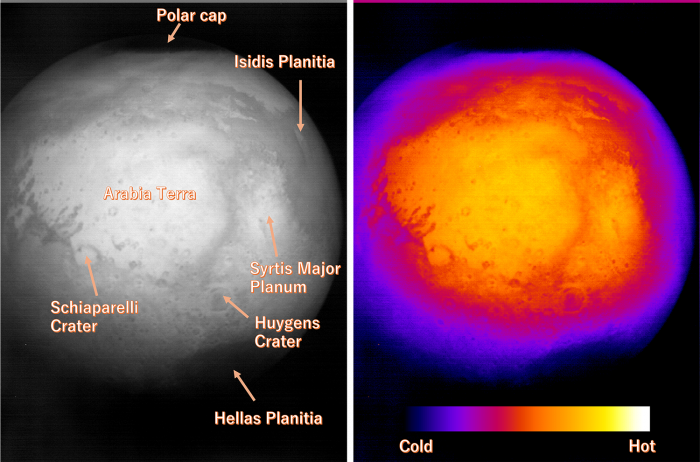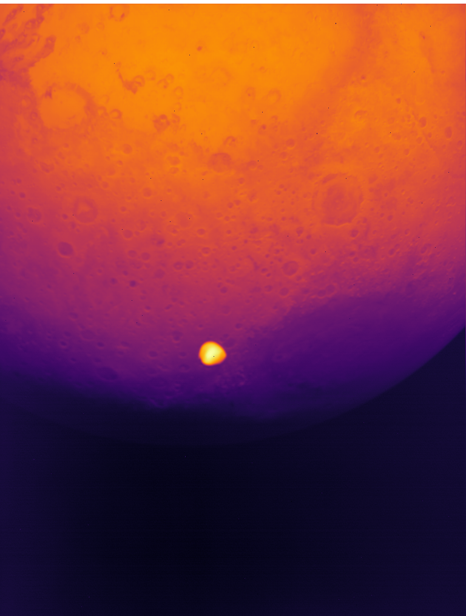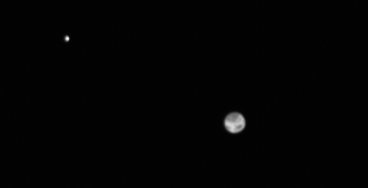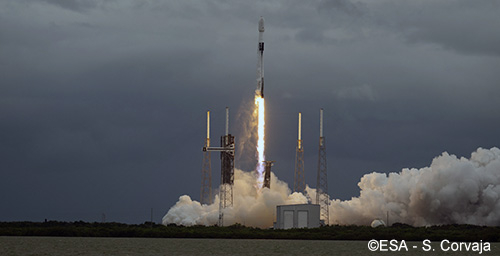Hera is a binary asteroid exploration mission led by the European Space Agency (ESA) and equipped with the Thermal InfraRed Imager (TIRI) developed by the Japan Aerospace Exploration Agency (JAXA). On March 12, 2025, the Hera spacecraft performed a Mars swing-by that utilized the planet's gravity to insert the spacecraft onto a trajectory towards the Didymos-Dimorphos binary asteroid system. Hera made its closest approach to Mars at 21:50 JST on March 12.
ESA has confirmed that the spacecraft condition is normal and that the Hera spacecraft has been successfully inserted onto the intended trajectory.
During the closest approach to Mars, the Hera spacecraft conducted observations of Mars and the Martian moon, Deimos, followed by the second Martian moon, Phobos, using three onboard cameras: the TIRI provided by JAXA, the visible light camera (Asteroid Framing Camera: AFC), and the visible and near-infrared spectroscopic camera (HyperScout-H).
Here, we take a look at the images of Mars and te planet's moon, Deimos, captured by the TIRI.
Figure 1: The red planet Mars imaged by the TIRI from a distance of approximately 40000 km. The Arabia Terra region can be seen, as well as the Polar Cap, below the detection limit of TIRI, and the Hellas Planitia, the largest crater in the Solar System, as a cold region. (Left) brightness temperature image, (right) Image showing high temperatures as warm colors. (credit: ESA/JAXA)
Figure 2: Thermal images of the Martian moon, Deimos captured by the TIRI from a distance of about 1000 km. (top)A series of images, (bottom) Image showing high temperatures as warm colors. (Credit: ESA/JAXA).
Movie: Deimos passing Mars (Credit: ESA/JAXA).
Deimos is the outermost of Mars's two moons, orbiting at a distance of about 23,400 km from the planet. It is also the smaller of the two moons, with a diameter of approximately 12 km.
Exactly how Deimos and the inner moon, Phobos, formed is not known. With their lumpy shape and very dark surfaces, the pair resemble asteroids not dissimilar from asteroid Ryugu that was visited by JAXA's Hayabusa2 mission. This suggests that the moons could have been captured by Mars's gravity after being scattered inwards from the outer Solar System. Alternatively, the moons may have formed due to a giant impact with Mars, and be a fragment of the red planet from a much earlier time.
These options will be explored further by JAXA's Martian Moons eXploration (MMX) mission, which plans to observe both moons to determine how they formed, and return a sample from the inner moon, Phobos.
The Hera spacecraft is scheduled to rendezvous with the binary asteroids, Didymos and Dimorphos, in December 2026 and conduct observations of the system for about six months. Periodic operational checks of the TIRI will take place throughout the journey in preparation for observations. After the Hera spacecraft arrives at the binary asteroid, TIRI will be used to conduct the first thermal property survey of an S-type (stony) asteroid, as well as to investigate the post-impact state after the collision from the United States National Aeronautics and Space Administration (NASA)'s Double Asteroid Redirection Test (DART).
As a planetary defense initiative led by ESA, Hera will continue to lead the world's first planetary defense program, AIDA (Asteroid Impact & Deflection Assessment), together with NASA's DART.
Okada Tatsuaki, Associate Professor at the Institute of Space and Astronautical Science (ISAS), Department of Solar System Sciences / Hera ISAS Project Team Leader
"The Hera spacecraft has now made it through the first hurdle after launch, the Mars swing-by, and has now been placed onto a trajectory towards the binary asteroids, Didymos and Dimorphos. As a technological demonstration for planetary defenseーpreventing asteroids from colliding with the Earthーand to elucidate the formation process of planets, including the Earth, we will strive to deliver many results through valuable scientific observations. We also hope that the observations of Mars and its moons will serve as a good bridge to the Martian Moons eXploration (MMX) mission."
Kuramoto Kiyoshi, Specially Appointed Professor, Institute of Space and Astronautical Science (ISAS), Department of Solar System Sciences / Martian Moons Exploration Project Team Principal Scientist
"I would like to congratulate the Hera spacecraft on the successful Mars swing-by, and observations of the Martian moons. Our Martian Moons eXploration (MMX) mission (scheduled for launch in FY 2026) will undertake detailed observations of the Martian moons, collecting a sample from Phobos and conducting flyby observations of Deimos. We hope that the observational data obtained by the Hera spacecraft will be useful in refining the observational plan for Deimos by MMX, and that, when combined with the data collected by MMX, it will help us in elucidating the origin of the Martian moons, one of the goals of the MMX mission."







